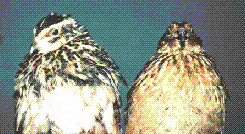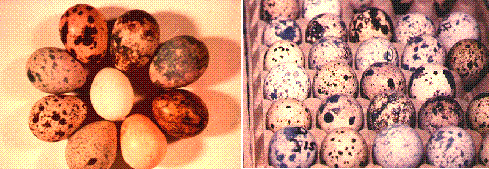Japanese quails are produced mainly for their eggs and meat. Starters from day-old to four weeks of age are reared in brooder cages provided with strong lighting to give heat. They are fed 3 times daily with quail starter mesh. Growers and layers are from four weeks to about one year old. They are housed in layer cages which are 5 or 6-tiered. They are fed with quail layer or breeder feed twice daily. Lighting is left on during the night to stimulated the birds to lay eggs. The nutritional requirements of Japanese quail for protein, amino acids, vitamins and minerals will be discussed.
History of The Japanese (Coturnix) Quails
Quail belong, along with chickens, pheasants and partridges to the Family Phasianoidea of Order Galliformes of the Class Aves of the Animal Kingdom. Species or subspecies of the genus Coturnix are native to all continents except the Americas. One of them Coturnix coturnix or common quail are migratory birds of Asia, Africa and Europe. Several interbreeding subspecies are recognized, the more important being the European quail, Coturnix coturnix coturnix, and the Asiatic or Japanese quail, Coturnix coturnix japonica. One subspecies that commonly migrates between Europe and Asia was eventually domesticated in China. These birds were raised as pets and singing birds. The domesticated coturnix were brought at about eleventh century to Japan from China across the Korean bridge (Howes, 1964). In any event, coturnix were first domesticated in the Orient and not in the Middle East as has been claimed by some authors. Although European coturnix migrating south in the fall across the Mediterranean Sea were, in their exhausted condition, easily caught or trapped the available Egyptian and Biblical records do not indicate that these birds were ever bred in captivity.
The first written records of domesticated quail in Japan date from the twelfth century. These birds were initially developed for song. It is claimed that a Japanese Emperor obtained relief from tuberculosis after eating quail meat, and this led to selection of domestic quail for meat and egg production in Japan in the latter part of the nineteenth century (Howes, 1964). By 1910, the Japanese quail in Japan were widely cultured for their meat and eggs. Between 1910 and 1941, the population of Japanese quail increased rapidly in Japan especially in the Tokyo, Mishima, Nagoya, Gifu and Toyohashi areas. This period also represented a time of imperial expansion in Japanese history and domesticated Japanese quail were established in Korea, China, Taiwan an d Hong Kong, and later on spread to Southeast Asia.
The domesticated subspecies, Coturnix coturnix japonica, is called Japanese quail but is also known by other names: Common quail, Eastern quail, Asiatic quail, Stubble quail, Pharaoh’s quail, Red-throat quail, Japanese gray quail, Japanese migratory quail, King quail, and Japanese King quail. The correct popular nomenclature for Coturnix coturnix japonica should be Japanese quail or coturnix, but not coturnix quail since in Latin “coturnix” may be translated as quail.
Description
Coturnix Chick:

Young coturnix are yellowish in appearance with stripes of brown and somewhat resemble turkey poults except for size. The newly hatched chicks weigh about 6 to 7 grams, but grow rapidly during the first few days. After three days flight feathers begin to appear and the birds are fully feathered about four weeks of age. Partial sexing is possible by three weeks of age by the cinnamon-colored feathers on the breast of the male bird, but there are some birds that defy definite sexing by this method, eve n when adults.
Adult Male:
 Male (right) and Female (left) Quails
Male (right) and Female (left) Quails
The adult male coturnix weighs about 100 to 140 grams (3 1/2 to 5 ounces). The male birds can be identified readily by the rusty brown colored feathers on the upper throat and lower breast region. Males also have a cloacal gland, a bulbous structure located at the upper edge of the vent which secretes a white, foamy material. This unique gland can be used to assess the reproductive fitness of the males (Cheng, Hickman and McIntyre (1985). The young birds begin to crow at 5 to 6 weeks old. Sanford (19 57) described the voice of the male as a loud, castanet-like crow, producing sound as “pick-per awick” or “ko-turro-neex”. During the height of the normal breeding season, coturnix males will crow throughout the night.
Adult Female:
The adult female coturnix are slightly heavier than the male, weighing from 120 to 160 grams (4 to 5 1/2 ounces). The body coloration of the female bird is similar to the male except that the feathers on the throat and upper breast are long, pointed, an d much lighter cinnamon. Also, the light tan breast feathers are characteristically black-stippled.
Quail Eggs:
Coturnix eggs are characterized by a variety of color patterns. They range from snow white to completely brown. More commonly they are tan and dark brown speckled or mottled brown with a chalky blue covering. The average egg from mature female weighs a bout 10 grams (1/3 ounce), about 8 percent of the body weight of the quail hen as compared to 3 percent for chicken eggs. The egg of Japanese quail contains 158 Cal. of energy, 74.6% water, 13.1% protein, 11.2% fat, and 1.1% total ash. The mineral content includes 0.59 mg calcium, 220 mg phosphorus and 3.8 mg iron. The vitamin content is 300 i.u. of vitamin A, 0.12 mg of vitamin B1, 0.85 mg of vitamin B2 and 0.10 mg nicotinic acid.



